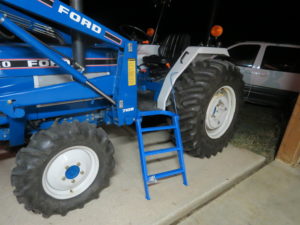

Skilled tradesmen use heavy machinery for material handling, lifting & carrying 

With all the benefits of machinery, climbing to the seat is difficult on skid steer loaders, forklifts, tele-handlers, dump trucks, tractors, log skidders, excavators, backhoes, etc. The machinery operator station protects the worker and provides good visibility, but it is high above the ground because of the large traction wheels needed to drive over rough ground. The first ladder step on machinery is typically 20 to 28-inches tall and the step surface is small. Maximum range of motion and strength of hips and shoulders is required to reach the step and pull up onto it. Additional steps up to the operator station are 11 to 17-inches tall and irregular in shape and distance. The tall and irregular position plus small surface area of steps on heavy machinery make it impossible for workers with leg, back and arm impairments to safely access the operator’s station.
Fold-down ladders custom built for heavy machinery provide direct access to the operator station for workers with physical limitations. Custom ladders are designed specifically for the needs of the worker based on his strength and range of motion. The step width and depth, rise between steps, grab rail position and slope of the ladder are carefully planned. The ladder design must not interfere with other workers who operate the machinery. The lowest section of the ladder extends to the ground and then folds up with a lifter rod or electric actuator controlled from the operator’s seat. With custom designed folding ladders, skilled workers with disabling illness or injury can safely climb to the operator’s station and continue their careers.
Powerful, large machinery is used by many skilled tradesmen to complete laborious tasks. Workers with disabilities especially need access to machines to dig, lift, carry, drag, cut and handle materials. Access ladders to the operator station are a barrier to the workers who need this machinery the most. Fold-down ladders custom built for heavy machinery provide direct access to the operator station for workers with physical limitations. With custom designed folding ladders, skilled workers with disabling illness or injury can safely climb to the operator’s station and continue their careers.
